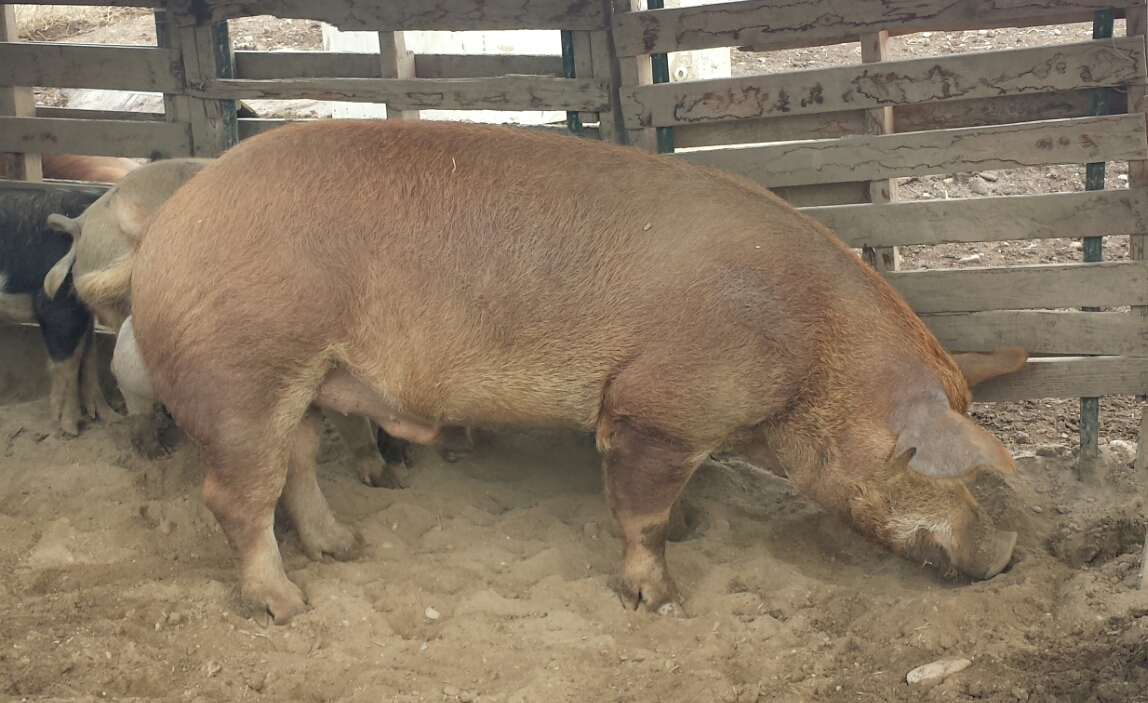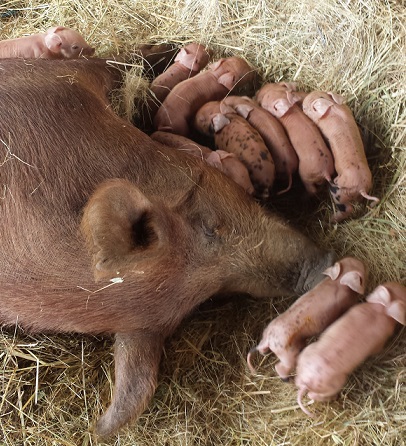Tamworth Hogs
The Tamworth hog is a slow growing breed that is appreciated as a great bacon hog due to its deep sides and ability to grow large without putting on too much extraneous fat. Being slow growing, Tamworths were traditionally pasture raised and thus have evolved for a pasture lifestyle. We raise purebred Tamworths and also cross our Tamworth sows with our Berkshire boar for amazing pork that is a little leaner than the purebred Berkshire.

Bubba - Our Tamworth boar
Our Heritage Tamworth breeding stock are all registered with the Tamworth Swine Association. Our hogs come from old farm lines, not modern show stock, so are taller and more narrow than a show hog. They have good feet and legs on them for traveling around their pasture and gentle personalities for easy handling.
The Tamworth are thought to be one of the oldest and purest breeds in England. They originated in Ireland and were known to be great grazers and foragers. They were imported to Tamworth, England in the 1800s and it is from there they derived their name. In his 1883 book "Harris on the Pig", Joseph Harris describes proper pig management in the 1800s - what we would now call pasture and woodland grazing of pigs. ( Ironic that people now think of pasture manaement as the "new way" to raise hogs.) Of the Tamworth breed he writes "Mr Thomes Wright of Quarry House, Great Barr considers the cross of the Berkshire with the Tamworth 'produces the most profitable bacon pigs in the kingdom'".
Heritage hogs thrive living outdoors and eating a natural diet. They have thick hair and pigmented skin that protect them from the sun. They enjoy rooting in the dirt, making mud holes to wallow in, and running in playful herds.
The taste of pork is highly influenced by what a hog eats more so than any other farm animal. A hog eating sweet grains tastes sweet. A hog eating sagebrush tastes like sage. There are even some farms that offer specialty diets for hogs like "cranberry and hazelnut" since that imparts a different taste in the meat. Good tasting pork starts with hogs that are fed a good tasting diet.
Equally important is feeding wholesome foods consistently through their life so that proper marbling is established as the hog grows in size. Forcing a hog to grow fast and "lean" on a high protein diet and then fattening it up in the last month will give you lean meat with lots of skin fat. It won't produce the marbling in the meat that keeps it moist when cooking and imparts such excellent flavor.
We also believe natural foods are the best for hogs and for the people eating our pork. Natural feeding means our hogs get a mixture of nutritional dense foods and roughage. They are never fed antibiotics, ruminant by-products, GMOs, or growth hormones. It takes hogs longer to grow on a natural diet but they are healthy, happy, and satiated during their life.
Our hogs live in a 19 acre pasture that has naturally seasonal grasses - green rye, vetch, wild barley, wild wheat, and forbes in the winter and dried standing grasses in our arid summer. The hogs make the rounds of the pasture whenever they desire - most often early morning and just after sunset. Their diet also includes: Home grown grain and pea hay,, wheat, barley, heirloom corn, and eggs. Everything we grow here is non-GMO. Locally grown grain hay, alfalfa, wheat, barley, oats, peas, and beans (all non-GMO). Sometimes they get our cow or goat milk and whey (no hormones) and fresh (not rotten!) organic veggies.

